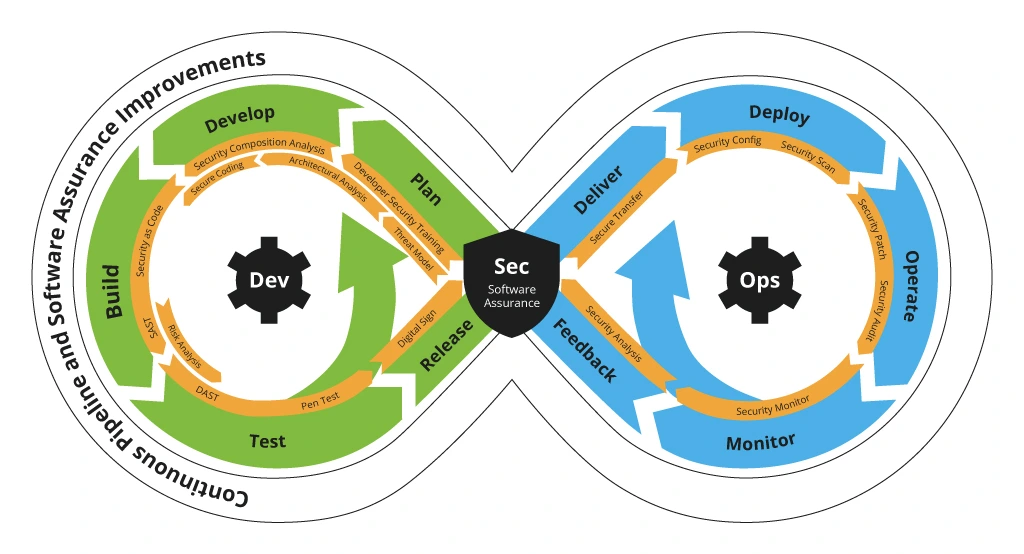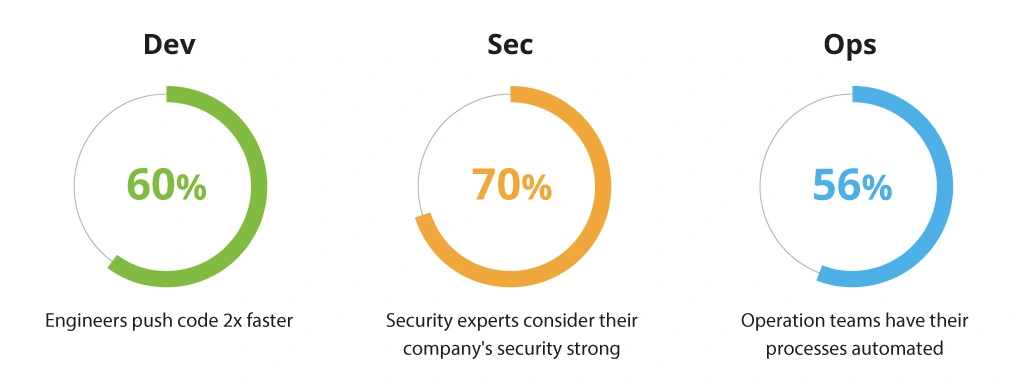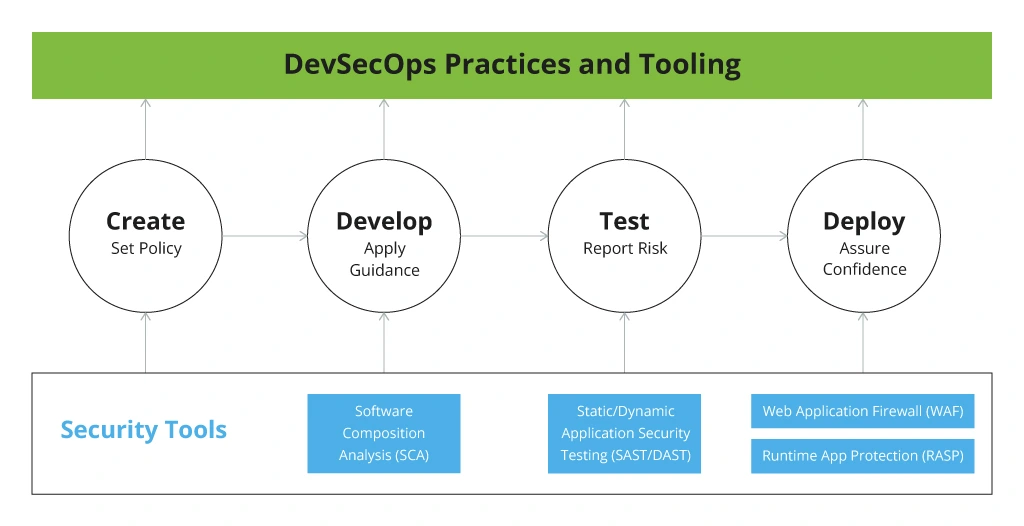DevSecOps: When Security Comes First
What is DevSecOps: DevOps ver. 2.0?
DevSecOps, the mecca of optimum protection, is all about taking care of security from the early stages of software development. Being an essential component of an end-to-end Software Development Life Cycle (SDLC) that many businesses adopted, the practice is about pre-planning security risks and the ways to eliminate them while iterating and not trying to tweak and tune the app post-production.
Let’s take a look at the main drivers that made DevSecOps not just an optional approach but engraved it into the very foundation of modern software development.
The DevSecOps CI/CD Pipeline

First, with mobile apps becoming our preferred means of information exchange, we have plenty of them making our lives more comfortable yet vulnerable to external factors. Since we consent to a lot of our personal information being processed via applications and websites, we bear the risk of data breaches.
The consequences of the latter can be irreversible: from the ruined reputation of a well-established business to the clients that are gone for greener pastures. For example, a recent incident at the Canadian branch of Ikea had over 95,000 locals falling victims to a privacy breach.
Second, early on, it was usual not to put security matters up the priority list. Moving forward, entrepreneurs understand the importance of strong security practices and their role in releasing a viable product.
Under these new circumstances, DevSecOps became a logical evolution of the previously established DevOps approach. It becomes even clearer if we unscramble the notion that Dev is about any product that works. DevOps means the product works in production. When we sandwich security in between, making it DevSecOps, we talk about a) a product that works, b) is secure for customers to use, and c) a company manufacturing it has a commercially viable product.
According to the 2021 Global DevSecOps Survey by GitLab, 60% of engineers admit they push code at twice the speed they did earlier, thanks to DevOps. More than 70% of security experts say the company’s security front stands somewhere between “good” and “strong,” the same study confirms. The operational side accelerates, too: more than half of operational teams report their tasks are either 100% or “mostly” automated.
DevSecOps Impact on Processes

How Does DevSecOps Benefit your Business?
When apps are moved to production, every security alert takes over 3 hours of a SecOps team, with each vulnerability consuming 10 hours of unplanned work for an engineer, reports a study. What can DevSecOps offer to business owners struggling to cope with similar problems?
Robust Security & Enhanced Customer Loyalty
What is better: to deal with the aftermath of a security incident or try to avert it before it happens? Organizations with DevSecOps in place attempt to avoid possible threats before they make any significant impact. They try to foresee what malicious actions can potentially hinder their regular operations, choosing a proactive approach.
The philosophy behind being proactive is about frequent monitoring of the threat landscape. Many companies reduce their business vulnerabilities by determining scenarios that might have negative consequences for the internal IT ecosystem and counteracting them. As a result, they eliminate the risks of reputation losses and customer attrition. With stable and secure operations, businesses can not only retain existing clients but also attract new ones and continue fostering trust in a brand.
Adaptability & Scalability for Businesses
As the latest DORA 2021 Accelerate State of DevOps report suggests, the companies ignoring DevSecOps have twice more chances of being doomed unreliable. Since business trustworthiness and security are interrelated, the latter has become a must-have rather than a luxury add-on.
Embracing DevSecOps culture allows companies to respond to the evolving business requirements quicker without compromising on operational efficiency. By embedding and further nurturing robust DevSecOps processes, cross-departmental collaboration, and rapport improvement, enable communication without borders.
In turn, such a reengineering of doing business gives organizations an advantage of scaling more easily and reacting to market trends promptly. For instance, 55% of organizations sometimes skip code security scans to meet deadlines and face unfortunate consequences related to security. With DevSecOps, they do not have to compromise on the reliability of their products and services in pursuit of more significant business expansion.
Elevated Resource Management & Cost Efficiency
Perhaps unsurprisingly, security issues can be the reason behind unforgivable downtimes. At the same time, reviving the code and tackling the consequences can be very expensive and require extra time, delaying software releases. Just a reminder: although close to 80% of organizations around the world use up to 10 different security solutions, 76% of businesses experienced downtime due to data loss in 2022 – the leading cause being system crashes.
Top Issues to Cause Downtimes

It is less of a problem when software is created in DevSecOps-powered environments, which proved to be time-efficient and cost-effective. With security in mind from the very start of the development process, there is no need to do multiple code reviews to make a product more secure.
DevSecOps procedures let security teams re-focus on strategic tasks while having more free time. These efforts can be channeled towards, for example, mentoring the junior workforce or thinking of ways to reinforce the DevSecOps processes further, encouraging ongoing improvement.
Sync with Business Continuity
Businesses that understand the necessity to ensure close collaboration between their cyber security and business continuity specialists can lower the spendings on technology and streamline recovery processes and incident response. DevSecOps, paired with well-defined BCP, guarantees a better focus on reliable threat detection and response techniques and a clear definition of the roles and responsibilities of each team member.
DevSecOps removes the likelihood of issues, bugs, and crucial problems being spotted too late. This swiftness guarantees greater compliance with lower chances of data breaches or other ad hoc problems that can appear later.
Think of DevSecOps as a seat belt that you fasten to eliminate security vulnerabilities early in software development. Security checks are embedded in a development cycle with automated root-cause analysis in place to enable traceability.
There are many proven instruments popular among the security community that can gather and elaborate on large piles of data that organizations can use to inspect risks in dynamics and build better business resilience with forecasting.
DevSecOps: Addressing Security Challenges of Businesses
While IT departments are on a mission to ensure that a business’s IT infrastructure and network have no security flaws, DevSecOps teams keep an eye on product security during their development and launch to market. They oversee process monitoring, compiling risk analysis, security controls automation, and incident management, among other tasks. DevSecOps help businesses achieve advance security with the following steps.
Building a Culture of Openness & Transparency
Creating DevSecOps processes and putting them on rails to tackle security challenges while building resilient businesses is not a matter of days. Bringing DevSecOps into the picture creates the foundation for transparent communication among business units and teams.
After the DevSecOps becomes a backbone of your development, tracking and monitoring of such complex initiatives as cloud migration, for example, and keeping all the parties involved in the loop are no longer a problem.
Gathering All Data at a Single Data Storage
Data management, along with the DevSecOps process suite, allows teams to collect the data from different sources and feed it back to the development to make quick improvements to work-in-progress applications. In a nutshell, DevSecOps implementation helps operation and technical squads elaborate on the collected information and convert it into intelligence that they can act upon. With such iterative improvements, the data insights flow under one roof with the end goal of enforcing smooth CI/CD.
Redefining Cloud with Security by Design
Around 57% of companies plan to shift more workloads to the cloud during 2022, claims the State of the Cloud Report.
Suppose businesses implement DevSecOps solutions at the app design stage. In such a case, they have more chances to guarantee the safety of workloads with code and assets designed and created with the emphasis on security at dawn.
Organizations can have DevSecOps as a stand-alone solution or a practice paired with an already existing ecosystem. Instruments and practices of DevSecOps can be reflected in the development life cycle in the following manner:

DevSecOps procedures and tools streamline the process of vulnerability detection and their fixes across the entire software development cycle from product creation to its deployment. Prior to the introduction of DevSecOps, software and application security checks were the last priority, quite often made towards the end of development. This underestimation of an early threat detection resulted in overhead costs and budget overspending.
Reimagining Builds and Testing Approach
Reducing the impact of the human factor with automation is essential. Thus, implementing a DevSecOps security toolkit or leveling up the development and operational practices with security tools allows for automated compliance and container security checks. Digital transformation and cloud migration are about learning and knowledge sharing among the technical staff that translates into better team coherence.
Implementing DevSecOps: Best Practices
As the cherry on top of the tool suite introduced above, the benefits of DevSecOps can be multi-played with these best practices when adopting the approach:
Bear in Mind Secure and Working Code as a Goal:
Lowering security vulnerabilities while having proven metrics directly linked to the development lifecycle can benefit any business. Envision the result you expect to achieve right from the start to build a concise and bespoke implementation strategy. An expertly crafted roadmap will help you transform your software development and deliver products fast and securely. The emphasis put right can help you avoid many pitfalls on the way.
Keep on Learning: The Tech Progress Never Stops
Evolving technology offers better deployment methods that every IT top manager should not ignore. The ability to quickly learn and explore fresh alternatives to outdated tools powers business growth and takes operations to new heights. You can opt for crafting region- or industry-specific success stories to define your customer preferences and reuse these lessons learned in the future.
Zen of DevSecOps: Agility and Alignment
How quickly and effectively your designers and engineers work directly impacts the success of DevSecOps pipeline and your business. The time it takes to add desirable functionality and check it for security might be significant. Remember: security should not be the last milestone to cover but, alternatively, it should be an integral part of each development lifecycle stage.
Final Thoughts
If you think the time is ripe to reconsider your organization security, DevSecOps is the right choice. With the numerous benefits the practice has, you can level up your product delivery time and ensure proactive approach to incident management. Considering the expert-guided advice Infopulse offers, you can easily transition to robust security management practices. Contact us to learn how to ramp up your software development with AWS DevSecOps services.
![Introduction to DevSecOps [banner]](https://www.infopulse.com/uploads/media/introduction-to-DevSecOps-1920x528.webp)


![Power Apps Licensing Guide [thumbnail]](/uploads/media/thumbnail-280x222-power-apps-licensing-guide.webp)
![How to Build Enterprise Software Systems [thumbnail]](/uploads/media/thumbnail-280x222-how-to-build-enterprise-software-systems.webp)
![Super Apps Review [thumbnail]](/uploads/media/thumbnail-280x222-introducing-Super-App-a-Better-Approach-to-All-in-One-Experience.webp)
![ServiceNow and Third-Party Integrations [thumbnail]](/uploads/media/thumbnail-280x222-how-to-integrate-service-now-and-third-party-systems.webp)
![Cloud Native vs. Cloud Agnostic [thumbnail]](/uploads/media/thumbnail-280x222-cloud-agnostic-vs-cloud-native-architecture-which-approach-to-choose.webp)
![DevOps Adoption Challenges [thumbnail]](/uploads/media/thumbnail-280x222-7-devops-challenges-for-efficient-adoption.webp)
![White-label Mobile Banking App [Thumbnail]](/uploads/media/thumbnail-280x222-white-label-mobile-banking-application.webp)

![Mortgages Module Flexcube [Thumbnail]](/uploads/media/thumbnail-280x222-Secrets-of-setting-up-a-mortgage-module-in-Oracle-FlexCube.webp)
![Challenges in Fine-Tuning Computer Vision Models [thumbnail]](/uploads/media/thumbnail-280x222-7-common-pitfalls-of-fine-tuning-computer-vision-models.jpg)